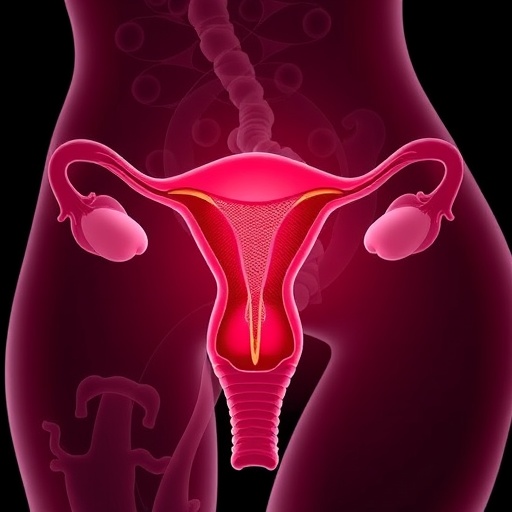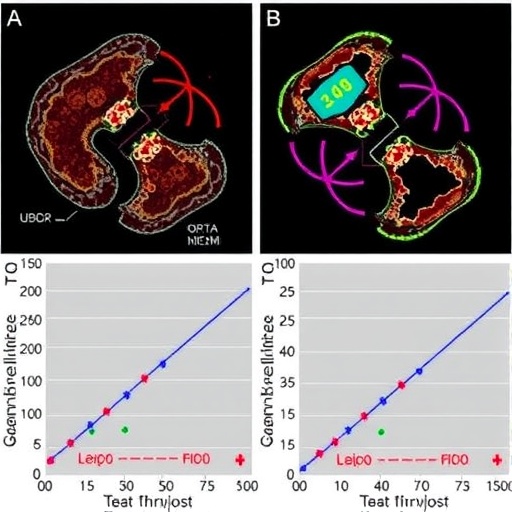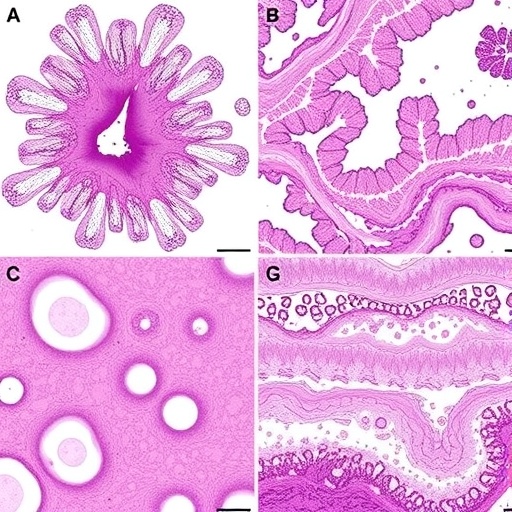In a groundbreaking exploration into the biochemical underpinnings of endometrial disorders, a recent study published in BMC Cancer has shed new light on the role of irisin—a hormone linked to energy metabolism and adipose tissue regulation—in patients diagnosed with endometrial atypical hyperplasia (EAH) and endometrial carcinoma (EC). This research marks a significant advancement in the understanding of the metabolic factors that may influence the development and progression of these gynecological conditions, which have traditionally been challenging to diagnose early and manage effectively.
Endometrial atypical hyperplasia is clinically recognized as a direct precursor to type I endometrial cancer, a malignancy strongly associated with metabolic disturbances such as obesity and insulin resistance. The intricate interplay between metabolic hormones, particularly adipokines secreted by adipose tissue, and the cellular dynamics of the endometrium has piqued scientific interest over the years. Irisin, a relatively newly identified hormone, has emerged as a potential player due to its regulatory role in glucose metabolism and energy expenditure, making it a prime candidate for investigation in the context of endometrial disease.
This cross-sectional case-control study involved a cohort of 88 patients who were clinically diagnosed with either EAH or EC. The investigators meticulously quantified serum irisin levels in these patients and compared them with a matched control group free of endometrial pathology. The analytical approach was comprehensive, leveraging both univariate and multivariate statistical models to control for confounding covariates, thus ensuring the robustness and reliability of the observed associations between irisin levels and disease states.
The results of the study were compelling and statistically significant. Patients with either EAH or EC demonstrated markedly elevated levels of serum irisin compared to the control population, with a p-value of 0.022 underscoring the strength of this correlation. This elevation suggests a dysregulated hormonal milieu in the affected individuals, which may contribute to or reflect the pathological processes occurring within the endometrial tissue.
Crucially, further multivariable analysis revealed that the association between increased irisin levels and EAH remained statistically significant even after adjusting for potential confounding factors (p = 0.018). This finding implies a potentially independent role of irisin elevation in the early hyperplastic changes that presage malignant transformation. In contrast, while irisin levels were also higher in patients with overt endometrial carcinoma, this association attenuated in the adjusted analysis, losing statistical significance (p = 0.071), which may reflect the complexity of hormonal regulation in established cancer.
These nuanced findings open new avenues for considering irisin not just as a biomarker for disease presence but perhaps as a mediator in the pathophysiological pathway linking metabolic dysregulation to endometrial proliferation and malignancy. The differential associations seen between EAH and EC in relation to irisin levels suggest that hormonal changes may evolve through the disease continuum, warranting further longitudinal studies to map these trajectories in detail.
Historically, the detection and prediction of progression from endometrial atypical hyperplasia to carcinoma have relied heavily on histopathological examination and imaging modalities, which carry limitations in sensitivity and specificity. The identification of circulating biomarkers like irisin could revolutionize clinical practice by enabling less invasive, more timely, and potentially preventative strategies based on metabolic profiling.
Moreover, the study’s findings resonate with broader research trends linking metabolic health to cancer risk. The interplay between obesity, insulin resistance, inflammation, and hormonal imbalances is increasingly recognized as a fertile ground for carcinogenesis across various tissues. Irisin, as a myokine and adipokine with systemic effects, encapsulates this intersection, acting at the nexus of metabolism and cellular signaling pathways relevant to tumor biology.
From a mechanistic standpoint, irisin is known to be involved in the browning of white adipose tissue, enhancing thermogenesis and energy expenditure. Its role within the endometrium, however, remains less clear, prompting hypotheses that it may influence cellular proliferation, apoptosis, or the tumor microenvironment through autocrine or paracrine mechanisms. Elucidating these pathways could unveil novel therapeutic targets, particularly for metabolic interventions that complement conventional oncologic treatments.
Notably, the authors emphasize the need for larger-scale studies to validate their findings and to establish the clinical utility of measuring irisin levels. The heterogeneity of endometrial cancer subtypes, patient metabolic backgrounds, and potential confounders necessitate expansive datasets and multicenter collaborations to refine the diagnostic and prognostic value of irisin.
In conclusion, this study pioneers the assessment of irisin as a biomarker bridging metabolic dysregulation and endometrial pathology. Its demonstration of elevated irisin levels in EAH and EC patients compared to controls not only enhances our understanding of disease biology but also paves the way for metabolic biomarkers to inform personalized risk stratification and early intervention strategies. As the epidemic of metabolic syndrome and obesity continues globally, such insights bear increasing significance for women’s health and cancer prevention frameworks.
Future research building on these findings will likely explore the longitudinal patterns of irisin fluctuations pre- and post-treatment, its interaction with other adipokines and metabolic hormones, and its precise cellular mechanisms within the endometrial milieu. Such integrative efforts could ultimately translate into innovative clinical applications encompassing screening, prognosis, and novel therapeutic avenues targeting metabolic pathways.
The compelling evidence linking irisin to EAH and EC presented here underscores a critical paradigm shift toward metabolically informed oncologic research and clinical care. Progress in this realm promises to refine our approach to managing endometrial pathologies and mitigate the burden of one of the most common gynecologic malignancies worldwide.
Subject of Research: Irisin hormone levels in patients with endometrial atypical hyperplasia and endometrial carcinoma
Article Title: Exploring irisin levels in patients with endometrial atypical hyperplasia and carcinoma: a comparative analysis
Article References:
Bildacı, T.B., Ata, C., Atlıhan, U. et al. Exploring irisin levels in patients with endometrial atypical hyperplasia and carcinoma: a comparative analysis. BMC Cancer 25, 1440 (2025). https://doi.org/10.1186/s12885-025-14843-0
Image Credits: Scienmag.com
DOI: https://doi.org/10.1186/s12885-025-14843-0





